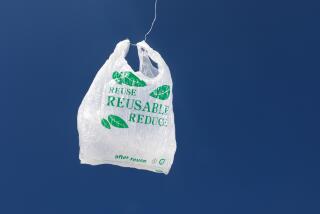A Hue and Cry Over Legal Pads : Environment: The recycling movement has made the office favorite a bit of an endangered species. It seems white is the color of choice--and value--for recyclers.
- Share via
For writers, lawyers, business executives and anyone who has ever coaxed their gray cells into action by doodling, the yellow legal pad provides an almost mystical link to the muses.
But the yellow pad’s popularity is being threatened. In some offices, it is becoming a white yellow legal pad because white recycled paper brings more money than color scrap; in others, the legal pad is showing up in ecological designer shades, from sage green to soft mauve.
Prompting the color debate is the national recycling trend. In guidelines published last February, the Environmental Protection Agency set a goal of 25% reduction in waste by municipalities by 1992. California law requires municipalities to achieve a 25% recycling rate for all waste products by 1995 and 50% by 2000.
According to the American Paper Institute, a national trade group, one-third of the country’s 600 paper mills are already producing only recycled paper.
In California, corporations like Hewlett-Packard, Wells Fargo Bank and Intel Corp., as well as government workers from Orange County to San Francisco, have started tossing their paper trash into office recycling bins.
But by saving scratch pads and memos from becoming landfill, environmentalists are raising the issue of what color paper their offices will use.
The choice is a matter of ecological economics, paper industry experts say. Colored paper is a lower grade than white and, while some paper recyclers handle all kinds of paper, others want only white, which brings more money.
Companies that throw all their paper--regardless of color--into one bin may not get the same returns on their efforts as those firms that separate white from colored paper.
“If white paper gets you the highest price, why buy paper that’s yellow or blue?” says Joan Edwards, head of the Los Angeles city government’s recycling program.
Within a year, Edwards says, the city plans “to purge” its yellow pads. Rather than earning nothing for recycling mixed paper, the city expects to make anywhere from about $50 to $80 a ton from its all-white paper program.
“It will be like getting rid of your security blanket,” Edwards admits of the switch. “People will say, ‘Oh, no, we can’t do that.’ But after it’s done, they’ll realize it doesn’t make a lot of difference whether the paper was yellow or white.” (Some manufacturers, however, say yellow is easier on the eyes than white, although they are similarly priced.)
“There’s nothing magical about yellow paper,” insists Tony Massaro, director of the Denver Mayor’s Office of Environmental Affairs, which began buying all-white office paper last fall, earning about $60 a ton for recycling it.
Massaro reports no withdrawal symptoms, even among the city’s attorneys. “We haven’t had a single complaint,” he says.
At the Los Angeles law firm of O’Melveny & Myers, however, a recycling program begun a month ago allows the 225 attorneys to continue note-making on yellow legal pads.
“The lawyer with the yellow legal pad is etched into everyone’s mind as the appropriate way to do business, and I think there would have been a reluctance to give that up,” says Christopher Crain, a lawyer with the firm who helped spearhead the recycling effort.
The firm, which belongs to a building-wide recycling program, chose “the convenience of using any kind of paper we want” over profit-making, explains Crain, saying that by recycling, the company gets reduced trash-hauling rates.
The next step, Crain hopes, will be getting lawyers to separate colored and white paper into two recycling bins. “We’re trying to raise consciousness slowly,” he says.
The American Paper Institute reports a drop in colored paper products--from 16% in 1974 to 10% in 1988. “We’re seeing a big movement toward white office paper,” says Marshall Friedman, President of U.S. Recycling Inc. in Denver, which operates 50 collection sites across the country.
“They’re finding it brings them some money,” says Virgil Horton, the paper institute’s vice president.
The yellow legal pad has also been victimized by the claim that it is more difficult to strip yellow than other colors from paper, says Bill Moore, head of recycling for Waste Management Inc. in Oak Brook, Ill., the country’s largest firm handling waste. Moore, who writes on a yellow legal pad, calls that claim “a myth.”
“We don’t have any problem (with recycling yellow paper),” says Harold Bergman, president of Riverside Paper Corporation in Wisconsin, which recycles 7,000-pound loads of paper in Mixmaster-like pulpers that strip off the ink.
At the start of the year, the company introduced an ecology line of paper in colors such as mauve and sage green, and since then, Bergman says, sales of legal pads have doubled. Focus groups preferred ecology colors, he says, saying they were easier on their eyes.
Nonetheless, when it comes to sales, white is still the company’s biggest seller in writing tablets. But, says Bergman, “we’re selling as many yellow pads as ever.”
More to Read
Inside the business of entertainment
The Wide Shot brings you news, analysis and insights on everything from streaming wars to production — and what it all means for the future.
You may occasionally receive promotional content from the Los Angeles Times.










